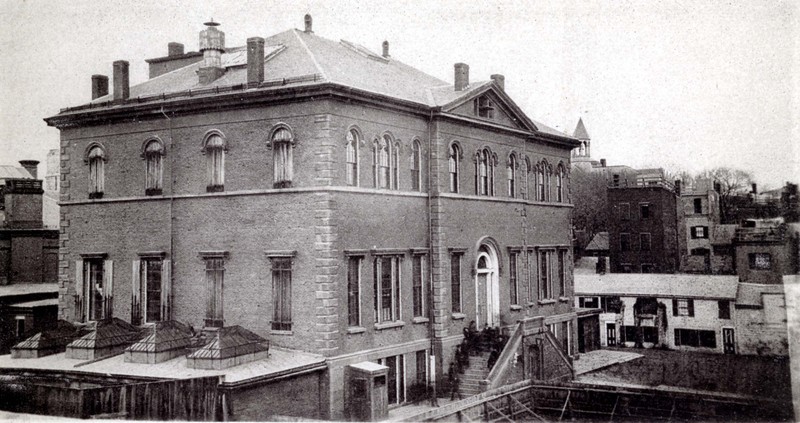The School on North Grove Street
In 1839, the lecture term was increased to four months, and in 1841, the Medical Faculty standardized a requirement for two full courses of lectures before graduation, making two grades in each year. The number of students continued to grow; enrollment had doubled by 1846, and as that year's catalogue boasted, "No medical institution in the country, as far as we know, has supplied a greater number of professors to schools created in various parts of the United States."
Space again became a pressing issue, and in 1847, Harvard erected another new building, on North Grove Street, adjoining Massachusetts General Hospital, on land donated by Dr. George Parkman—whose body would all too soon be found buried beneath it. The school building itself had nearly doubled in size (134 feet long and 60 feet wide), and the 1849 catalogue described it as "…of ample dimensions, and well warmed and ventilated throughout. It contains, on the second floor, two large Lecture rooms, the Chemical Laboratory, and the Library. On the floor above are the Theatre, in which the Lectures on Anatomy, Surgery and Pathological Anatomy, are delivered, the Professors' and Demonstrators' rooms…. The ground floor is occupied by the Janitor's apartments, rooms attached to the laboratory, etc. The Dissecting Room is a separate hall attached to the main building."
The North Grove Street building also provided accommodation for the institution's newest educational asset—the Warren Anatomical Museum. Retired from active teaching, Dr. John Collins Warren (1778-1856) presented his anatomical collection—over 1,000 specimens—to Harvard at the opening of the new building "… in which the collection could be fairly displayed, and sufficiently protected; thus affording the requisite means of opening the new Museum to the inspection of medical students and others interested in medical science."A new professorship in pathological anatomy was also created at this time, and its occupant, J. B. S. Jackson (1806-1879), became the Warren's first curator.
In 1858, the Harvard Corporation authorized the establishment of a summer term of medical study, from March to October, with lectures, demonstrations, clinical attendance, and examinations, as a practical supplement to the winter term beginning in November. "This method of instruction, by means of lectures during one portion of the year, and of recitations, study and clinical observation during the other, under the supervision of the same instructors, so that there is an adaptation between the lectures of the professors in the winter and the studies of the students in the summer, is believed to combine greater advantages than any other system."
Adoption of the summer term lengthened the course of medical study through almost an entire year, and by the end of the Civil War, there were regular enrollments of nearly 300 students in the winter term and 100 in the summer. There were also 100 medical graduates in the Class of 1866—the largest class size until the end of the 19th century. The size of the faculty also began to increase dramatically. A professorship in the physiology and pathology of the nervous system was established in 1864, and several of the original professorships now had adjunct faculty positions attached to them. Lecturers in specific subjects, such as ophthalmology and hygiene, and instructors were also appointed. The 1869 catalogue of the Medical School lists a faculty of nine full professors, three adjunct professors, one assistant professor, five instructors, four lecturers, and a demonstrator of anatomy. On other fronts, the Corporation established the Harvard Dental School in 1867 and a short-lived School of Veterinary Medicine in 1882. The Dental School had close ties to the Medical School and shared several members of its faculty.
In spite of these advances, the Medical School also confronted severe challenges during the middle of the 19th century. After the remains of George Parkman were discovered buried in the basement of the school, Harvard's Professor of Chemistry John W. Webster (1793-1850), was tried and convicted of murder, while Dean Oliver Wendell Holmes (1809-1894) and the faculty debated the possibility of admitting women and African-Americans to the Medical School in that same year. But the greatest difficulty Harvard would face was a fundamental question about the poor quality of American medical education at the time—and how to improve it.

